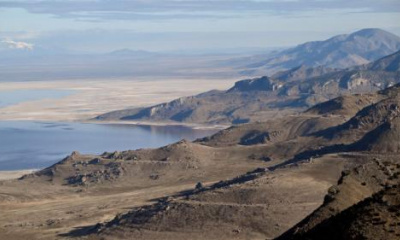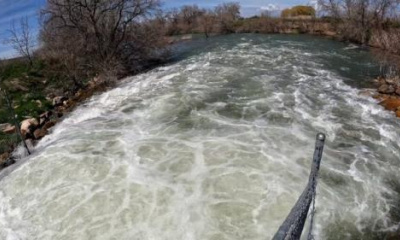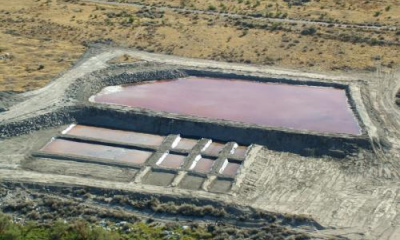SALT LAKE CITY — Tim Davis believes Utah must do everything it possibly can to help the Great Salt Lake avoid a repeat of 2022.
The lake plummeted to an all-time low amid ongoing extreme drought conditions that gripped the West, exposing a slew of environmental concerns. Storms tossed more dust toward the many Utahns living near the lake's eastern shoreline as its toxic lakebed became increasingly exposed. That was just one of the issues.
"Large parts of the ecosystem were starting to collapse," said Davis, Utah's Great Salt Lake deputy commissioner. "We need to develop a plan to make sure we don't go back to where the lake was."
The first version of a plan to help improve the lake is now public. The Office of the Great Salt Lake Commissioner unveiled its Great Salt Lake Strategic Plan on Monday after weeks of meeting with Utah leaders about it.
The 40-page document outlines how Utah can help the lake avoid returning to that record low 4,188.5 feet elevation and get it back to at least a healthy level of 4,198 feet elevation — and keep it there over the next 30 years.
Great Salt Lake Commissioner Brian Steed said Tuesday that it is the "initial strategy" to protect the lake while "balancing the other ecological, economic and societal interests surrounding the lake." It can be updated in the future.
Key parts of it include:
- It will take 471,000 to 1.055 million additional acre-feet of water to go toward the lake annually so that it can rise to that 4,198-foot elevation goal by the 2050s. The range is based on drought conditions.
- Utah should develop a short-term contingency plan to help prevent the lake's southern arm from dropping below 4,190 feet elevation any given year.
- It should also implement and refine tools that "ensure the long-term health of the Great Salt Lake." These include ways to track water consumption and flow better, and continuing studies on the lake.
- Utah should explore new funding and partnerships with different government and nongovernment entities to help study and maintain the lake's ecosystem and "to ensure species and food webs remain healthy and viable." This is on top of existing partnerships.
- It should continue to remove invasive species like phragmites to help restore the lake's wetlands, too.
Steed previously acknowledged that efforts longer than five years are "probably more realistic" because of how much water would be needed in a relatively short amount of time when he provided a preview of the plan. He added last week that it may be a "complicated effort" because of all the water rights details that would have to be sorted out to help the Great Salt Lake receive water.
While the desired outcome of 4,198 feet elevation may not happen anytime soon, the report recommends that Utah begin the planning and conservation work now. To that end, the commissioner's office is crafting a "detailed plan" in the next year to determine how much water is needed to be cut from every water consumption sector every year to reach the primary goal, Davis told KSL NewsRadio on Tuesday.
"Everyone needs to be pulling in the same direction," he said.
Not everyone is sold on it, though. Zach Frankel, executive director of the water conservation nonprofit Utah Rivers Council, told KSL.com that he appreciates the water need outlined in the plan, but he contends information about getting that water is too vague.
He argues that the plan lacks specific details of how and when the lake will reach 4,198 feet elevation, including a set goal of how much water to commit to the lake. He's also concerned with the idea that leaders may not address the issue as soon as possible if the goal is to have it reach its minimum healthy level in three decades.
"This really isn't a plan; it's an overview with some broad brushstrokes," he said. "The measures in the plan don't go far enough and it doesn't really commit us to anything very substantive in delivering water to the Great Salt Lake."
Other local and regional conservation groups voiced similar concerns on Wednesday. Stu Gillespie, senior attorney for Earthjustice's Rocky Mountain Office, called it "at best, a plan to prepare a plan."
The early work
The Great Salt Lake is still faring better than it did in 2022, but it's also not near its minimum healthy level. Its southern arm remains at 4,192.6 feet elevation, and its northern arm remains at 4,189.7 feet elevation, per the U.S. Geological Survey.
All of the goals to get it back to 4,198 feet elevation are broken down into short, medium and long-term periods.
Davis explains that "key work" this year will include finding better tracking of how much water is being saved from a "variety of conservation efforts," including agricultural water optimization, temporary or permanent water rights donations, and water conserved by municipal or industrial users. In addition, they want to better track that any water saved for the lake ends up in it.
This can be done through better coordination between various state and federal agencies that track water needs and consumption, while also establishing "more meaningful" coordination with nongovernment parties, according to the plan. Ten state agencies and five federal agencies have ties to the Great Salt Lake, and the plan aims to get everyone on the same page.
"We'll also be identifying how much water we need to get, each year, to the lake over the next 30 years to get to the healthy level and then keep it there," Davis said. "We're also working with different municipal, industrial, agricultural water users to help develop tools to ensure that we can get that amount of water to the lake each year over the next 30 years. That's what it'll take to get to the lake to the healthy level."
In addition to reducing consumption, he says the state may look into options such as "split-season leasing" as a potential solution. That's when an irrigation user agrees to use some water for their needs but cuts back to send some water to the lake under a monetary agreement with the state.
Multiple conservation group leaders say they want more certainties in the immediate future. That includes Frankel, who said he hopes that Utah will create more "substantive" measures, proposals and commitments to deliver water to the Great Salt Lake as these conversations continue.
"This document represents baby steps and we need to see leaps moving forward to deliver water to the Great Salt Lake," he said. "We need substance and meaning instead of fluff."
What's expected in the long term
Some of the other goals are recommended to be completed over the next five years. These include completing and implementing the Great Salt Lake Basin Integrated Plan, better modeling water needs for the population growth expected within the Greater Salt Lake economic region, creating more incentives to boost conservation, and developing ways to "maximize" any big water years.
There are a few long-term goals listed for the next six to 30 years; however, most of these feature ways to maintain and build on efforts from the first five years, based on what does and doesn't work.
Davis said the office will explore ways to "import" water from outside its primary tributaries, too. Any water imported into the lake now is through cloud seeding or the Colorado River via the Central Utah Project, and both of those tools could be utilized more in the future. However, that may not happen until the end of "that 30-year horizon."
In the meantime, he says residents along the Great Salt Lake Basin should continue to find ways to be as efficient with their water as possible as the state works to implement the plan.
"It'll take a long time," he said. "It'll be a lot of hard work, but ... I think the strategic plan lays out that we can get there."







